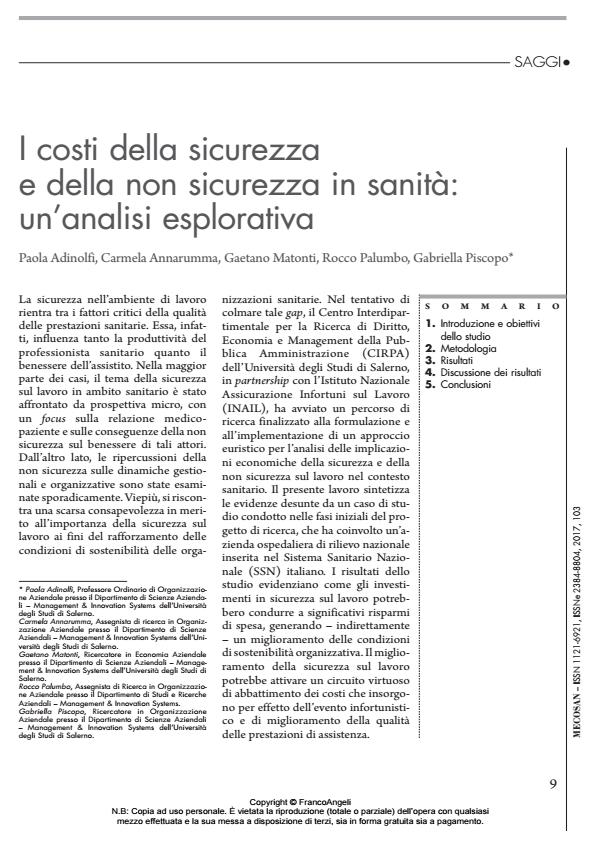I costi della sicurezza e della non sicurezza in sanità: un’analisi esplorativa
Journal title MECOSAN
Author/s Paola Adinolfi, Carmela Annarumma, Gaetano Matonti, Rocco Palumbo, Gabriella Piscopo
Publishing Year 2018 Issue 2017/103
Language Italian Pages 22 P. 9-30 File size 23730 KB
DOI 10.3280/MESA2017-103002
DOI is like a bar code for intellectual property: to have more infomation
click here
Below, you can see the article first page
If you want to buy this article in PDF format, you can do it, following the instructions to buy download credits

FrancoAngeli is member of Publishers International Linking Association, Inc (PILA), a not-for-profit association which run the CrossRef service enabling links to and from online scholarly content.
Risk management, miglioramento delle performance. Occupational safety (or work safety) is included among the critical factors which affect the quality of health services’ provision. Indeed, occupational safety influences both the health care providers’ productivity and the patients’ well-being. In most of the cases, occupational safety has been dealt with adopting a "micro" perspective, which focuses the attention on the patient-provider relationship and on the consequences of work unsafety on the well-being of these actors. Alternatively, the effects of occupational unsafety on managerial and organizational dynamics have been infrequently investigated. Therefore, there is a limited awareness of the importance of occupational safety to increase the sustainability of health care organizations. To contribute in filling this gap, the Interdepartmental Center for the Research in Law, Economics and Management of Public Sector Organizations (CIRPA) launched a research project in partnership with the National Institute of Work Injuries Insurance (INAIL), which was aimed at designing and implementing a heuristic approach to examine the economic implications of occupational safety and unsafety in health care organizations. This paper reports on a case study, which was performed during the initial stages of this project. It involved a hospital of national relevance operating within the Italian National Health Service (INHS). The study findings emphasize that occupational safety may pave the way for significant cost savings and indirectly contributes in enhancing the sustainability of health care organizations. The improvement of organizational safety allows to enact a virtuous cycle, reducing health care costs attached to work-related injuries and enhancing health services’ quality.
Keywords: Safety, Quality, Efficiency, Risk management, Performance improvement.
- La riorganizzazione delle prestazioni sanitarie in ottica di appropriatezza: l'esperienza dell'AOU "San Giovanni di Dio e Ruggi d'Aragona" nella gestione del DRG 127 - Insufficienza cardiaca e shock Lucia Soriente, Silvio Cigolari, Alberto Gigantino, Chiara Aliberti, Pasquale Ardovino, Paola Adinolfi, Rocco Palumbo, in MECOSAN 115/2021 pp.7
DOI: 10.3280/MESA2020-115002 - Il costo della perdita di produttività del personale ospedaliero: una valutazione economica applicata ad un intervento di prevenzione Caterina Cavicchi, Emidia Vagnoni, in MECOSAN 124/2023 pp.65
DOI: 10.3280/mesa2022-124oa16062
Paola Adinolfi, Carmela Annarumma, Gaetano Matonti, Rocco Palumbo, Gabriella Piscopo, I costi della sicurezza e della non sicurezza in sanità: un’analisi esplorativa in "MECOSAN" 103/2017, pp 9-30, DOI: 10.3280/MESA2017-103002